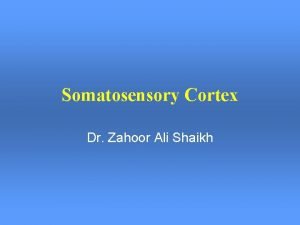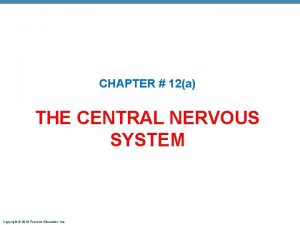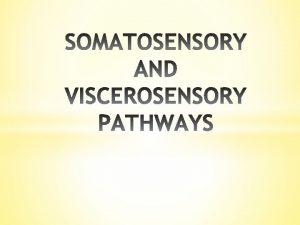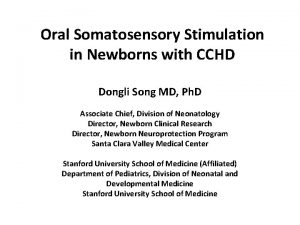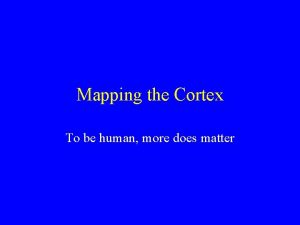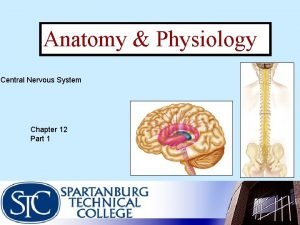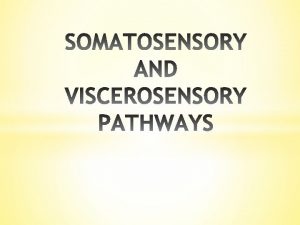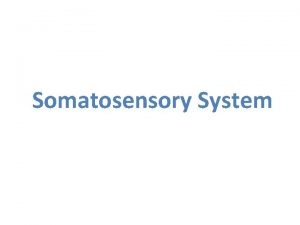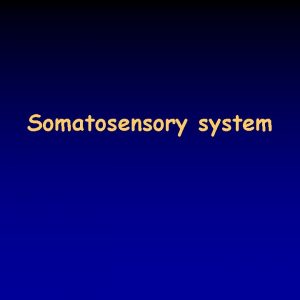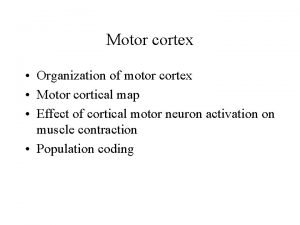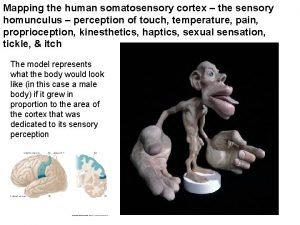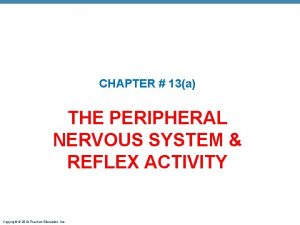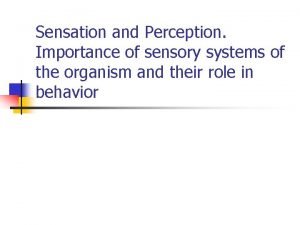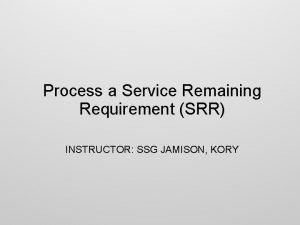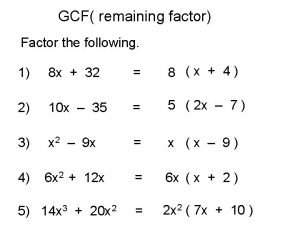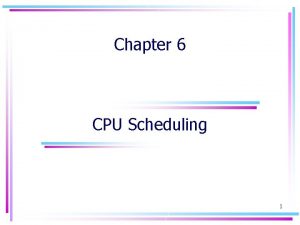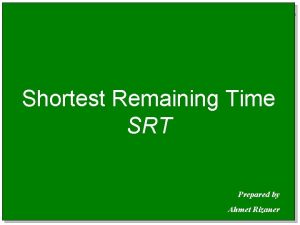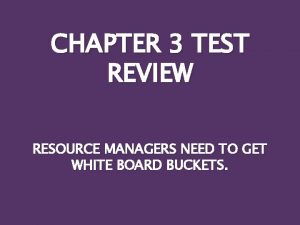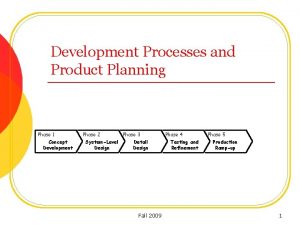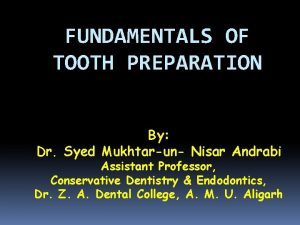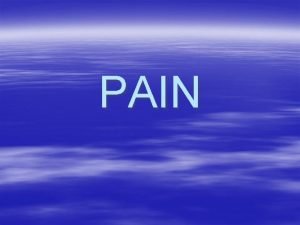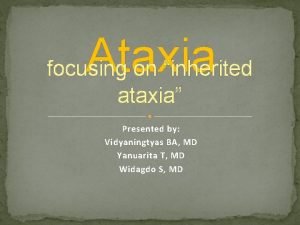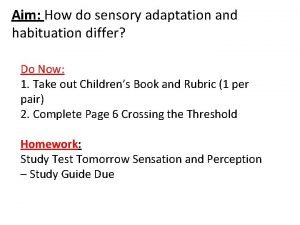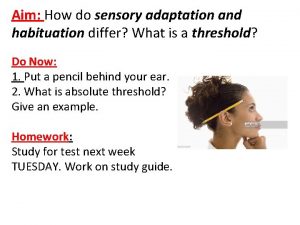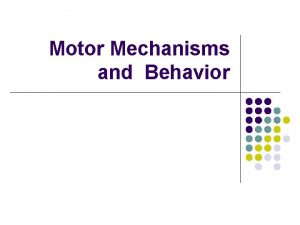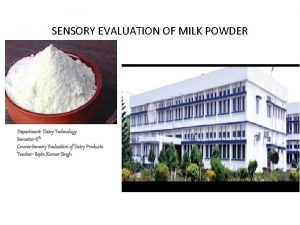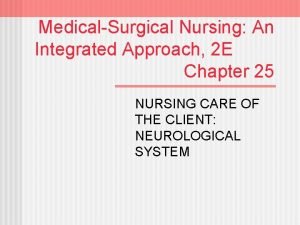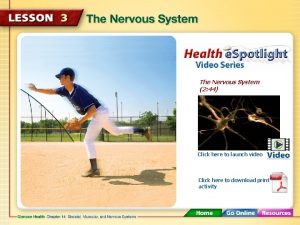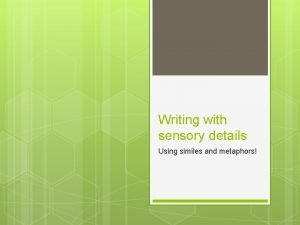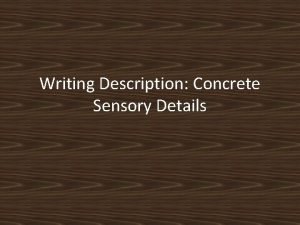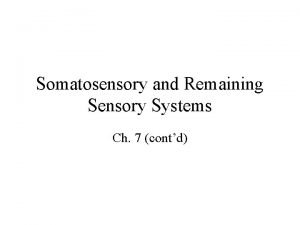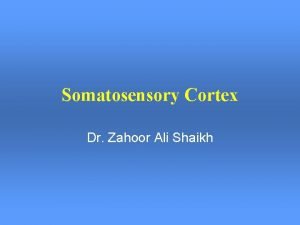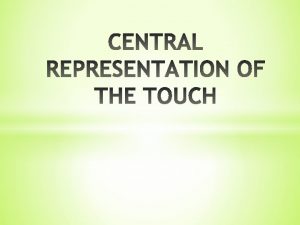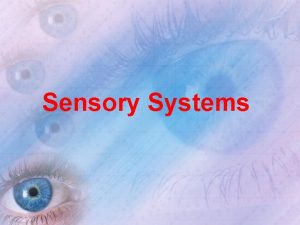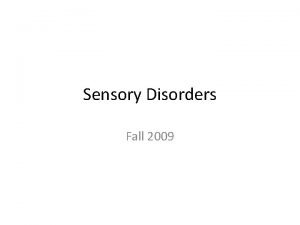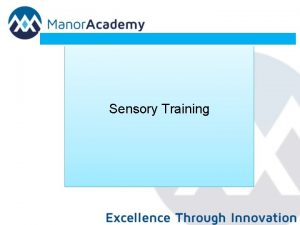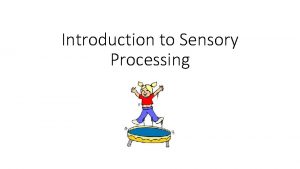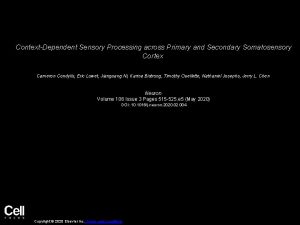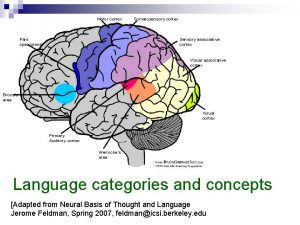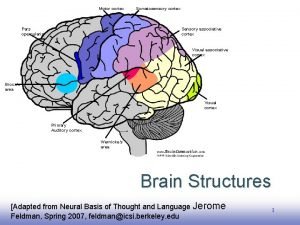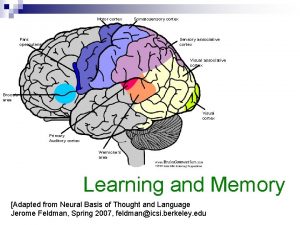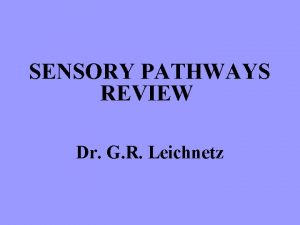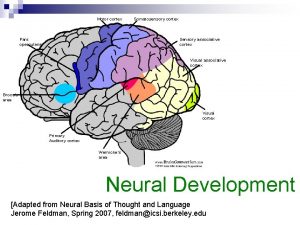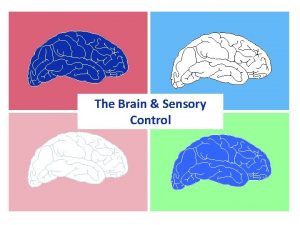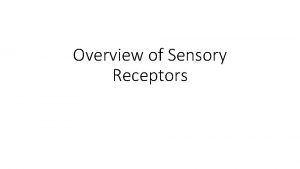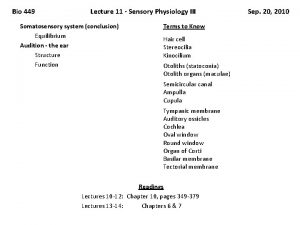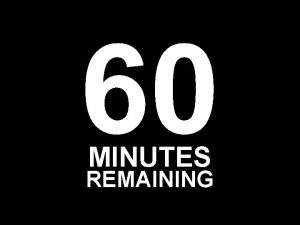Somatosensory and Remaining Sensory Systems Ch 7 contd














































- Slides: 46

Somatosensory and Remaining Sensory Systems Ch. 7 (cont’d)

Outline • • • Organization of the Somatosensory System Somatosensory Cortex The Olfactory System The Gustatory System Selective Attention

Organization of The Somatosensory System

The Somatosensory Subsystems • The somatosensory system comprises three subsystems: – exteroceptive cutaneous system – proprioception system (monitors body position) – interoceptive system (monitors conditions within the body such as blood pressure)

Somatosensory Cortex • The various thalamic nuclei receiving somatosensory information project to – Primary sensory cortex in the postcentral gyrus – Secondary somatosensory cortex – Posterior parietal cortex

Somatosensory Cortex • The primary somatosensory cortex is organized somatotopically; it is known as the somatosensory homunculus • Instead of one “homunculus”, the primary cortex is comprises four parallel somatotopically organized strips, each sensitive to a different kind of somatosensory input

Somatosensory Homunculus

Somatosensory Cortex • Large lesions to parietal cortex occasionally produce somatosensory agnosias – Astereognosia - loss of ability to recognize objects by touch in absence of of defects in somatosensation – Asomatognosia - is a loss of the ability to recognize parts of one’s own body

Pain and descending analgesia circuit • Stimulation of Periaqueductal grey produced analgesia in rats • Receptors for opiates analgesics in PAG, suggesting body produces its own opiates (endorphins)

Pain and descending analgesia circuit • DA circuit goes from PAG to raphe nucleus and then to dorsal columns to dorsal horns of spinal cord • Phantom limb pain - chronic severe pain that is experienced by about half of amputees


The Olfactory System • Smell is an olfactory system response to airborne chemicals; there about 1000 different olfactory receptors, each having its own special receptor protein • Although there appears to be no organization of receptors at the level of the olfactory mucosa, all receptors having the same receptor protein seem to project to the same area of olfactory (odotopic mapping)

The Olfactory System • Transduction of olfactory stimuli occurs in olfactory receptors located in the olfactory mucosa of the upper nasal cavity • Projections to various parts of the limbic system (which is responsible for the emotional perception of odorants) and to the medial dorsal nucleus of the thalamus • The DMN eventually passes the olfactory information on to the orbitofrontal cortex where the odor is consciously perceived

The Gustatory System • Taste operates in tandem with smell; gustatory receptors are called taste buds • There are four primary tastes: sweet, sour, bitter, and salty; however, these perceptions do not match up nicely with four simple gustatory receptors • Many flavors cannot be recreated by combinations of the primary flavors • Some flavors seem to activate taste neurons by altering neural activity by activity on ion channels directly rather through a receptor

Selective Attention • Allows us to consciously perceive just a fraction of what we unconsciously sense • May be top-down or bottom-up • may be focused by internal cognitive processes (endogenous attention; topdown) or by external events (exogenous attention; bottom-up)

Selective Attention • Change blindness is classic example of the effects of selective attention; it can be demonstrated by alternately showing subjects two pictures that are identical in every aspect but one. If there is a brief delay between each picture, subjects often take a long time to spot what becomes an obvious difference between the pictures once they are attending to the right location

Selective Attention • Different parts of the brain mediate attention to different types of stimuli; for example faces activate the ventral visual pathway while the position of that face activates the dorsal visual pathway

Forebrain Structures of the Sensorimotor System Ch. 8

Outline • • • Principles of Sensorimotor Function Posterior Parietal Association Cortex Dorsolateral Prefrontal Association Cortex Secondary Motor Cortex Primary Motor Cortex Cerebellum and Basal Ganglia

Hierarchical Organization • The sensorimotor system is organized like a large effective company; the “president” (associated cortex) issues general commands and lower levels (motor neurons and muscles) take care of details; the advantage of this hierarchical arrangement is that higher levels are left free to focus on the complex functions

Motor Output is Guided by Sensory Input • Like a large company, the sensorimotor system carefully monitors the external world and the consequences of its own actions, and it acts accordingly; only ballistic movements (brief, all-or-none, high speed movements) are not guided by sensory feedback

Learning Changes the Locus of Sensorimotor Control • As a new company develops, more and more tasks become part of the routine and are taken over by lower levels of the organization; the same thing happens in the sensorimotor system; after much practice lower levels perform well-learned tasks with little higher involvement

Posterior Parietal Association Cortex • Before an effective response can be initiated, the sensorimotor system must know the positions of various parts of the body and of objects in he external world; current thinking is that the posterior parietal cortex performs this function

Posterior Parietal Association Cortex • The posterior parietal cortex receives input from visual, auditory, and somatosensory systems ( that is why it is considered to be associated cortex) most of its output goes to secondary motor cortices • In addition to disrupting the accuracy of movements, large lesions of posterior cortex can produce apraxia and contralateral neglect

Apraxia • Apraxia is the inability to perform movements when requested to do so ( in the absence of simple sensory or motor deficits, motivational deficits, or intellectual deficits) for example an apraxic patient may have difficulty demonstrating hammering movements when asked to do so but be perfectly capable of spontaneously hammering a nail

Apraxia • Apraxia is almost always associated with left hemisphere damage, but its symptoms are always bilateral • Right parietal damage often produces deficits on the WAIS block-design subtest; this is referred to as constructional apraxia

Apraxia • Other type of apraxia called object apraxia - patient uses wrong object for certain programmed movements (like brushing teeth with a comb instead of toothbrush) • (in class video)

Contralateral Neglect • Patients with contralateral neglect fail to respond to visual, auditory, and somatosensory stimuli from the contralateral half of the body • Contralateral neglect is usually produced by very large right parietal lesions • Patients with contralateral neglect may shave only the right half of their face, eat food from only the right half of their plate, put only their right leg in their pants

Dorsolateral Prefrontal Association Cortex • Projections to this area are from the posterior parietal cortex; this area in turn projects to parts of the secondary motor cortex, the primary cortex, and to the frontal eye field


Dorsolateral Prefrontal Association Cortex • Research on nonhuman primates has suggested that the prefrontal association cortex is involved in assessment of external stimuli and the initiation of responses to them; neurons here may be activated by characteristics of an object, its location, or by the response that the object elicits

Dorsolateral Prefrontal Association Cortex • Further research shows that the motor neurons firing the earliest (prior to a motor task) are located in the dorsolateral prefrontal cortex, indicating that this area may be key in decisions regarding voluntary response initiation

Secondary Motor Cortex • There are three areas of secondary motor cortex: the premotor cortex, the supplementary motor area, and the cingulate motor areas. They all send information to primary motor cortex; all receive input from primary motor cortex; all are interconnected with one another; and all send axons to the motor circuits of brainstem

Secondary Motor Cortex • Functionally, each of these areas produces complex movements when stimulated; are activated both before and during voluntary movements; and are active when either side of the body is involved in a movement

Secondary Motor Cortex • Premotor cortex neurons often respond to both visual and touch stimuli; it appears to encode spatial relations of external cues and program movements guided by these cues

Secondary Motor Cortex • Much of the supplementary motor area (SMA) is in the longitudinal fissure • The cingulate motor cortex lies on the cingulate gyrus, just below the SMA • Secondary motor cortex is involved in the planning, programming and generation of complex motor sequences

Primary Motor Cortex • Primary motor cortex is in the precentral gyrus of the frontal lobe; it is somatotopically organized • The motor homunculus has a disproportionate representation of hands and mouth; in fact, two different areas of each primary cortex control the contralateral hand

Motor homunculus

Primary Motor Cortex • Neurons in primary motor cortex seem to code for a preferred direction of movement; they fire most just before and during the movement; they fire most when the movement is in the preferred direction and less as the direction deviates from the preferred one

Primary Motor Cortex • Lesions of primary motor cortex produce contralateral asterognosia; they reduce the speed and force of contralateral movements, and they make it difficult to move one body part independently of others (They do not produce paralysis)

Cerebellum and Basal Ganglia • Both are important subcortical sensorimotor structures, but neither participates directly in the transmission of signals to the spinal cord • Their role seems to be to integrate and coordinate the activity of structures at various levels of the sensorimotor system

Cerebellum • The cerebellum constitutes 10% of the brain’s mass, but it contains over half the brain’s neurons; it is organized systematically in lobes • It receives inputs from primary and secondary motor cortex, from brainstem motor nuclei and from somatosensory and vestibular systems

Cerebellum • It is thought to correct deviations from intended movements • effects of diffuse cerebellar damage include loss of the ability to precisely control movement, to adjust motor output to changing conditions, to maintain steady postures, exhibit good locomotion, to maintain balance, to speak clearly, and to control eye movements

Cerebellum • Long-recognized role in motor learning, more recently appreciated for a role in the fine-tuning and learning of nonmotor cognitive responses

Basal Ganglia • The basal ganglia are part of a loop that receives information from various parts of the cortex and transmits it back to motor cortices via the thalamus

Basal Ganglia • Basal ganglia are involved in sequencing of movements, like the cerebellum, its role has recently been expanded to include a variety of nonmotor cognitive tasks • Basal ganglia function compromised in patients with Parkinson’s Disease (due to loss of dopamine from substantia nigra) and Huntington’s Disease (due to loss of cells in basal ganglia)
 Address contd
Address contd Somatosensory area
Somatosensory area Somatosensory association cortex
Somatosensory association cortex Somatosensory
Somatosensory Somatosensory
Somatosensory Homunculus of primary somatosensory cortex
Homunculus of primary somatosensory cortex Homunculus of primary somatosensory cortex
Homunculus of primary somatosensory cortex Somatosensory
Somatosensory Somatosensory
Somatosensory Somatosensory system
Somatosensory system Cortical areas
Cortical areas Somatosensory map homunculus
Somatosensory map homunculus Somatosensory cortex
Somatosensory cortex Sensory systems
Sensory systems Srr extension
Srr extension Modifiers of human acts fear
Modifiers of human acts fear Which was easier finding the remaining factor
Which was easier finding the remaining factor Shortest remaining time first scheduling
Shortest remaining time first scheduling Shortest remaining time (srt)
Shortest remaining time (srt) Designs may be frozen with too many imperfections remaining
Designs may be frozen with too many imperfections remaining Divide remaining
Divide remaining Complete the scale by labeling the remaining tick marks
Complete the scale by labeling the remaining tick marks Staying faithful to god in hard times
Staying faithful to god in hard times Bài tập định thời cpu
Bài tập định thời cpu Plan the remaining development project
Plan the remaining development project Suspension liners vs solution liners
Suspension liners vs solution liners Decision support systems and intelligent systems
Decision support systems and intelligent systems Wilda pain scale
Wilda pain scale Difference between cerebellar ataxia and sensory ataxia
Difference between cerebellar ataxia and sensory ataxia Sensory adaptation vs habituation
Sensory adaptation vs habituation What is habituation
What is habituation Pterion
Pterion Sensory and motor mechanism
Sensory and motor mechanism Sensory evaluation of milk and milk products
Sensory evaluation of milk and milk products Sensory input integration motor output example
Sensory input integration motor output example Cranial nerves sensory and motor
Cranial nerves sensory and motor Nervous
Nervous Vestibular nerve
Vestibular nerve Motor and sensory nerve
Motor and sensory nerve Incoming sensory impulses and outgoing motor impulses
Incoming sensory impulses and outgoing motor impulses Tina champagne trauma informed care
Tina champagne trauma informed care Dicapine
Dicapine Embedded systems vs cyber physical systems
Embedded systems vs cyber physical systems Engineering elegant systems: theory of systems engineering
Engineering elegant systems: theory of systems engineering Sensory metaphor examples
Sensory metaphor examples A paragraph must contain
A paragraph must contain Concrete detail definition
Concrete detail definition

